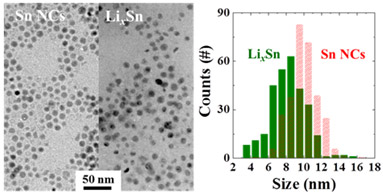Scientific Achievement

Homogenous, 10nm Sn nanocrystals were prepared as a model platform to study the impact of crystal size on mechanical deformation during electrochemical cycling with lithium. Using ex-situ TEM, significant damage was observed after the first lithiation, explaining the capacity decay observed after 50 cycles. Size reduction at these scales is insufficient to prevent mechanical damage caused by electrochemical cycling.
Significance and Impact
Alloy-based materials are being considered as electrodes in high energy density Li ion batteries, but their performance is compromised by large volume changes during cycling. Despite expectation that downsizing crystals would avoid mechanical damage, this work suggests that some particle damage may be inevitable. Thus, future research might be better directed toward compensatory mechanisms for this process.
Research Details
- Monodisperse Sn spherical nanocrystals of 10.0 ±0.2 nm were used as a model platform to study the impact of size on the accommodation of colossal volume changes during electrochemical lithiation.
- Their dispersibility enabled an ex situ TEM study whereby grids loaded with nanocrystals were electrochemically cycled prior to evaluation of morphological deviations.
- Significant mechanical damage was observed after full lithiation, indicating that even crystals at these very small dimensions are not sufficient to prevent particle pulverization that compromises electrode durability.

